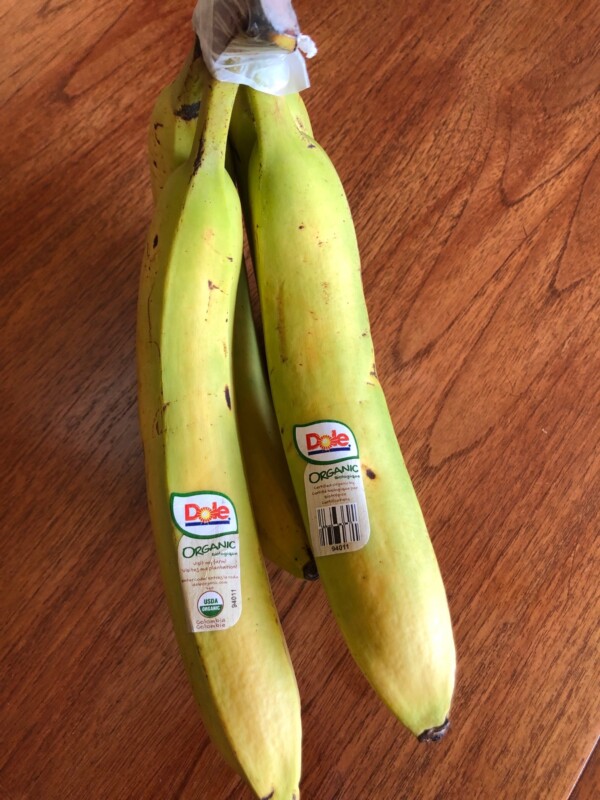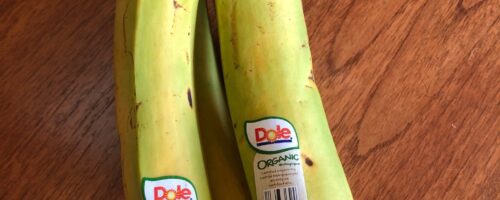
90, Santa Marta, Magdalena, Colombia
How is it produced?
This bunch of bananas was produced by the Dole company in Colombia, where bananas are the country’s third most important export (Beekman et al, 2019, p.7). In 2013, Colombian bananas had an export value in excess of 700 million USD, accounting for 11% of total global banana exports (Beekman et al, 2019, p.7).
These bananas retailed for 99 cents/pound at my local grocery store. Their non-organic counterparts are even cheaper at 69 cents/pound. By comparison-organic Argentinian oranges, arguably a less exotic fruit retailed for 2.49/pound. It is likely that between 1-3% of the retail cost of these bananas went to the workers on the plantation.
Banana workers in Colombia make between 4,287 pesos ($1.12 USD) and 3,632 pesos ($0.95 USD) per hour (Beekman et al. p8).
The bananas were first planted, grown, harvested and bagged at banana plantations
the bananas are among the poorest and most vulnerable in the world. Many suffer from hunger and are excluded from social services (Beekman et al, 2019, p.13). Multinational fruit companies like Dole, ignore labour codes and workers rights, forcing plantation workers to work ten to twelve hours a day while only being paid for eight. Plantation labour is backbreaking and there is no compensation or medical treatment for the frequent accidents that occur. Child labour, sexual harassment and gender-discrimination are common on banana plantations (Cohen, 2009).
Describe the supply chain to the store shelf in Canada:
After these bananas left the plantation, they were transported to a factory, where they were washed, sorted, measured and packed. The factory workers face similar working conditions and hours to those on the plantation. They spend long hours on their feet, washing the bananas in a variety of chemicals with unprotected hands (Cohen 2009).
After being quarantined and receiving customs clearance for export, the bananas were exported by sea transport, which requires the use of refrigerated freighters, to prevent the fruit from ripening prematurely. This type of shipping, has been estimated to account for five percent of the world’s carbon dioxide emissions (Cohen, 2009).
Once ripe, these bananas were transported by road transport to a wholesaler, increasing their carbon footprint yet again. The bananas were then shipped to a grocery store creating more carbon dioxide and additional shipping waste, such as packaging. All stages of transport contribute to carbon emissions that negatively affect human health and lead to climate change.
What is the power balance between the producer and seller?
The banana exportation business has had firm ties to colonialism since its inception. The United Fruit Company, which now operates under the name Chiquita, was the first to capitalize on the economic and political instability in Central America by buying up large swaths of cheap land for their plantations. In the process, they gained huge economic and political power, creating their own “banana republics.” With the ability to control every aspect of production, banana prices were kept low and profits remained high. The banana trade experienced success to the detriment of other industries, creating “an unhealthy dependance on the banana,” in countries such as Colombia (Cohen, 2009).
Just as the traditional lands of Colombian people were seen as useless jungle to be transformed into cash crops, fruit companies saw the people of Colombia as cheap, expendable labor. On November 12th, 1928, they exerted their power against banana workers striking for improved working conditions. A thousand banana workers were killed on behalf of the fruit company in what came to be known as the banana massacre (Caro & Ortega, 2012).
Can you recommend changes to the system to improve the balance?
Several NGOs, among them “Banana Link,” have been working to improve conditions in the banana industry. An international banana charter has been created and with it, steps to improve social conditions around banana production, enforce health and safety standards and regulate supermarket prices. Unfortunately global retailers have refused to follow the charter and banana prices have dropped even lower, with even less money reaching plantation workers (Cohen, 2009).
The WTO has implemented a set of rules that states countries cannot refuse to buy bananas based on the treatment of workers or because of environmental practices. NGOs are attempting to change these rules so that importing countries don’t have to buy from countries that refuse to follow the banana charter (Cohen, 2009).
As individual I can choose to buy organic bananas from a company like Dole and try to forget that I am supporting a company that is committing these type of humanitarian and environmental atrocities. Ethical fair trade bananas are a great option but, sadly not available in my community. The final option is to simply not buy bananas, recognizing the humanitarian and environmental toll of such a small food choice around the world.
References/Resources:
Beekman, G., M. Dekkers & T. Koster. (2019). Towards a sustainable banana supply chain in Colombia; Rainforest Alliance Certification and economic, social and environment conditions on small-scale banana plantations in Magdalena, Colombia.
Caro J. & Ortega A. (December, 2012). The worker’s massacre of 1928 in the Magdalena Zona Bananera – Colombia. An unfinished story. Memorias. Retrieved July 17th from
Cohen, R. (June 12, 2009). Global issues for breakfast: The banana industry and its problems FAQ. The science creative quarterly. Retrieved July 12 from https://www.scq.ubc.ca/global-issues-for-breakfast-the-banana-industry-and-its-problems-faq-cohen-mix/

